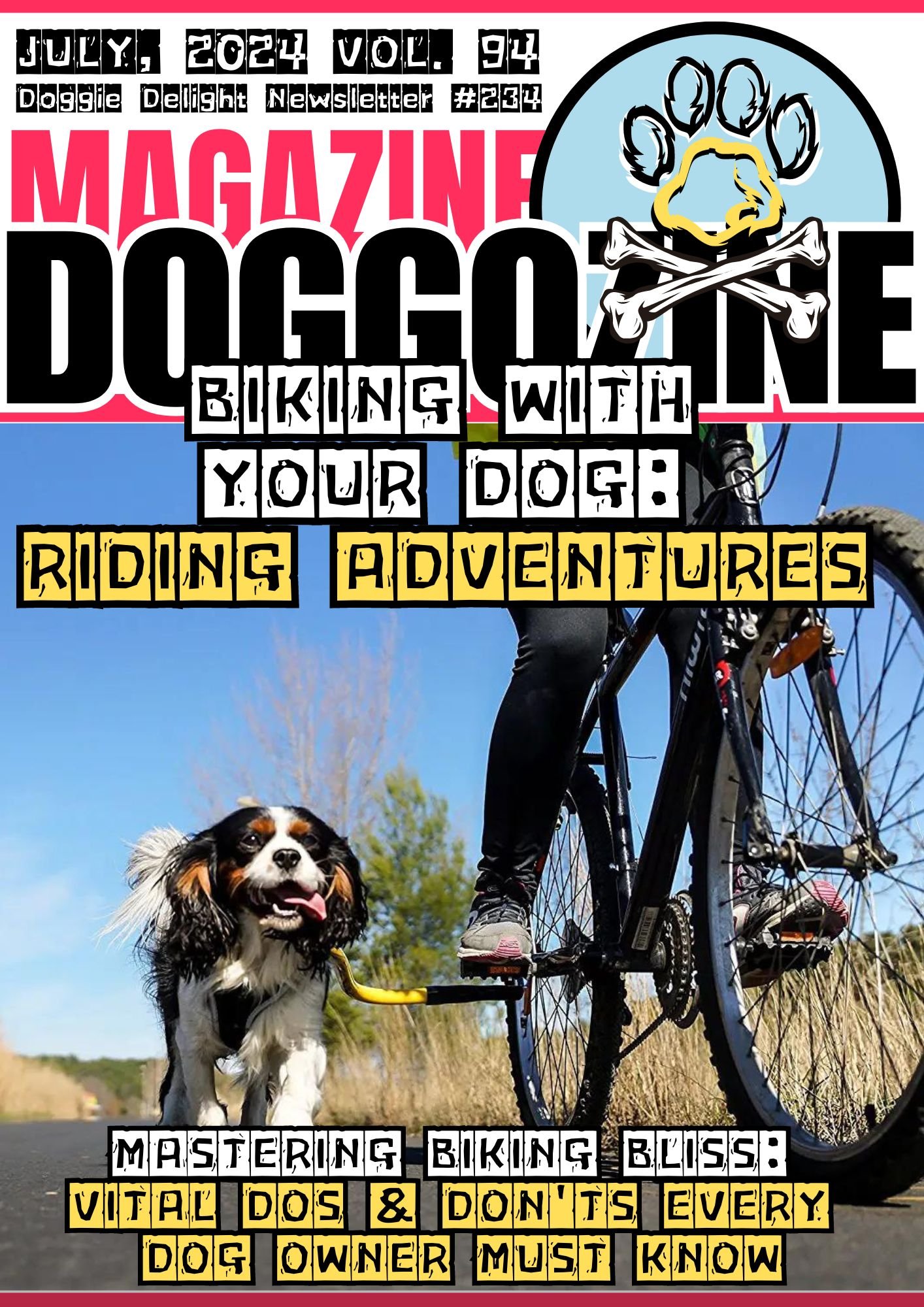
MASTER THE BIKING BLISS: VITAL DOS & DON’TS EVERY DOG OWNER MUST KNOW
Imagine the thrill of cruising on your bike alongside your loyal furry companion. The wind caresses your hair as you pedal together. You feel a sense of adventure mixed with safety and joy. This remarkable experience is “Biking with your dog.” As you explore scenic trails and picturesque routes, ensuring a smooth and enjoyable ride becomes essential. This article will reveal the key dos and don’ts for safe and harmonious biking with your canine friend.
Evaluate Your Dog Fitness Before Biking
From assessing your dog’s fitness to choosing the right gear, every aspect is carefully designed. It will enhance your bonding moments and create unforgettable adventures. Brace yourself as we delve into a world where biking becomes a blissful experience shared with your dog. Let’s pedal together and embrace the wonder of biking and canine companionship!
Before embarking on a biking adventure with your furry friend, evaluating their fitness level is crucial. Different dog breeds have varying exercise needs and capabilities. It’s important to consider your dog’s individual requirements. This will ensure a safe and enjoyable experience for both of you.
Select the Right Biking Gear for Your Dog and Master Control for Safety Practices
Choosing the appropriate biking gear for your dog is vital. It ensures their safety and comfort during the ride. A well-fitted harness or dog bike trailer can help keep your furry friend secure and prevent any accidents. Additionally, consider accessories like water bowls and poop bags to ensure a hassle-free journey.
Staying in control and following proper safety practices is essential. Teach your dog basic commands like “stop,” “slow down,” and “stay.” Start with short, low-speed rides to get them accustomed to the experience. Always keep a close eye on your furry companion and be prepared to stop or dismount if necessary.
Assess Your Dog’s Physical Capabilities
Take a careful look at your dog. Dogs of different breeds, ages, and overall health have varying abilities. Some breeds like cattle dogs or hounds are naturally more energetic and better suited for intense activities like biking. But short-nosed breeds or older dogs may have limits, so a slow start is best.
Start with Short Dog Runs with Rest Breaks for Hydration
Begin by taking short runs with your dog. See how they handle it and slowly increase distance over time. This lets you gauge if your dog can keep up with biking. Staying hydrated and taking regular breaks is crucial for both you and your dog. Pack plenty of water and collapsible bowls.
Plan your route with designated rest stops where your furry friend can re-hydrate and catch their breath. Monitor their energy levels and adjust the pace or duration accordingly. Before starting a new exercise routine, it’s wise to speak with your vet. They know your dog’s needs and can warn of any health issues.
🔑 Key Points: Check your dog’s fitness. Consider their breed and needs. Ask your vet before starting to bike with your pup.
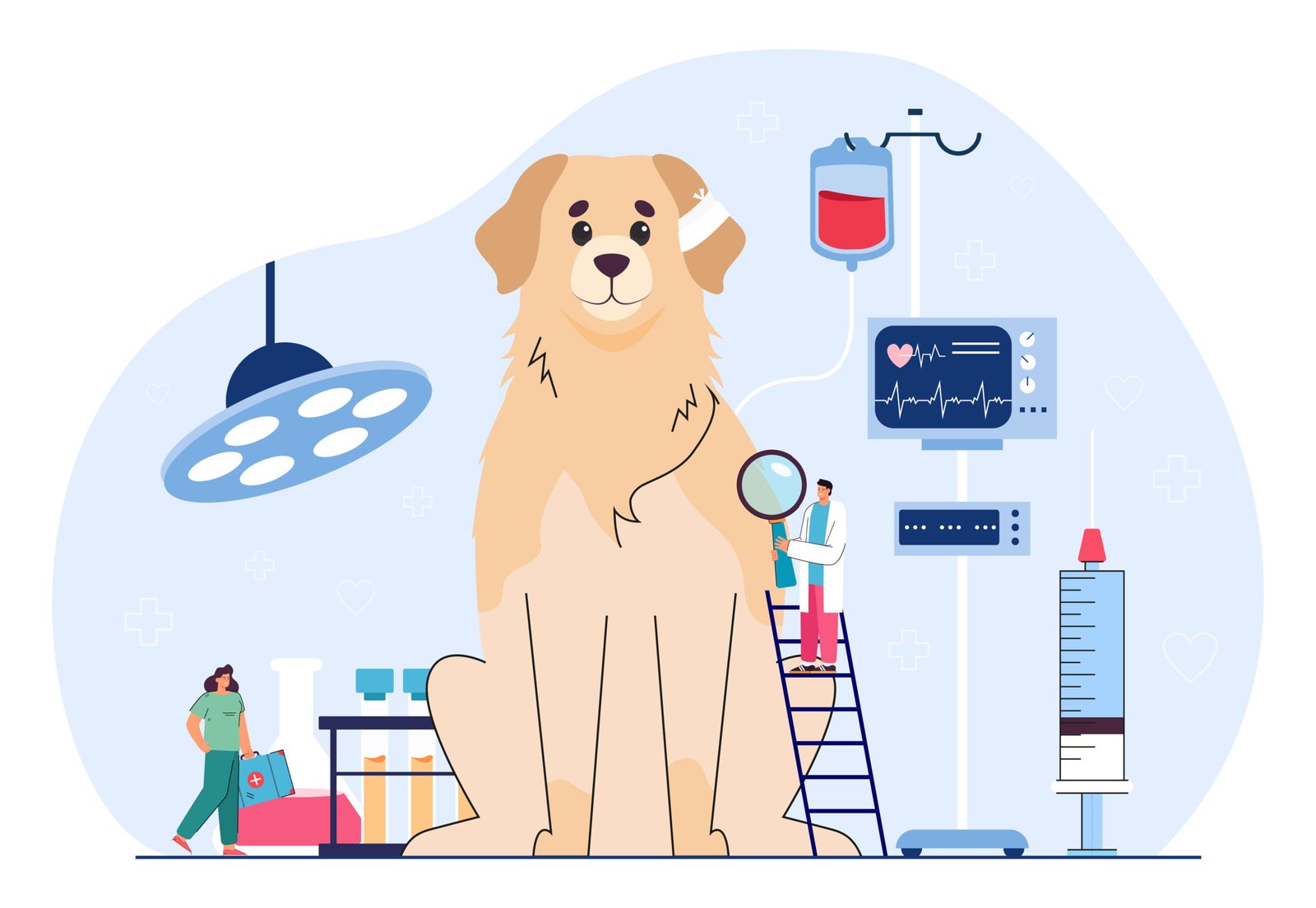
THE IMPORTANCE OF VETERINARY ADVICE FOR BIKING WITH YOUR DOG
Ask your vet before biking with your active dog. They understand your dog’s health and can say if they’re ready for trails. It’s very important for you and your dog both to be in good shape and ready for this adventure.
Addressing Breed-Specific Concerns and Ensuring Your Dog’s Health and Safety
Different breeds have different traits and health risks. Your vet knows issues that could impact safe biking. For instance, short-nosed breeds may struggle breathing, while big breeds risk joint pain.
Before you start biking with your furry friend, it’s crucial to have your veterinarian perform a thorough health check. They’ll ensure your dog is in good physical condition. Your vet can also provide guidance on proper nutrition and hydration. They can recommend any necessary vaccinations or preventive measures.
Tailoring an Exercise Plan
Each dog has unique needs and fitness levels. Your vet can help create a tailored exercise plan. They’ll recommend appropriate distances, terrains, and rest intervals. This ensures your dog stays safe and healthy while biking.
🔑 Key Points: Consulting your vet is essential. They’ll address breed-specific concerns and ensure your dog’s health and safety. They’ll also create a personalized exercise plan for biking with your active dog.
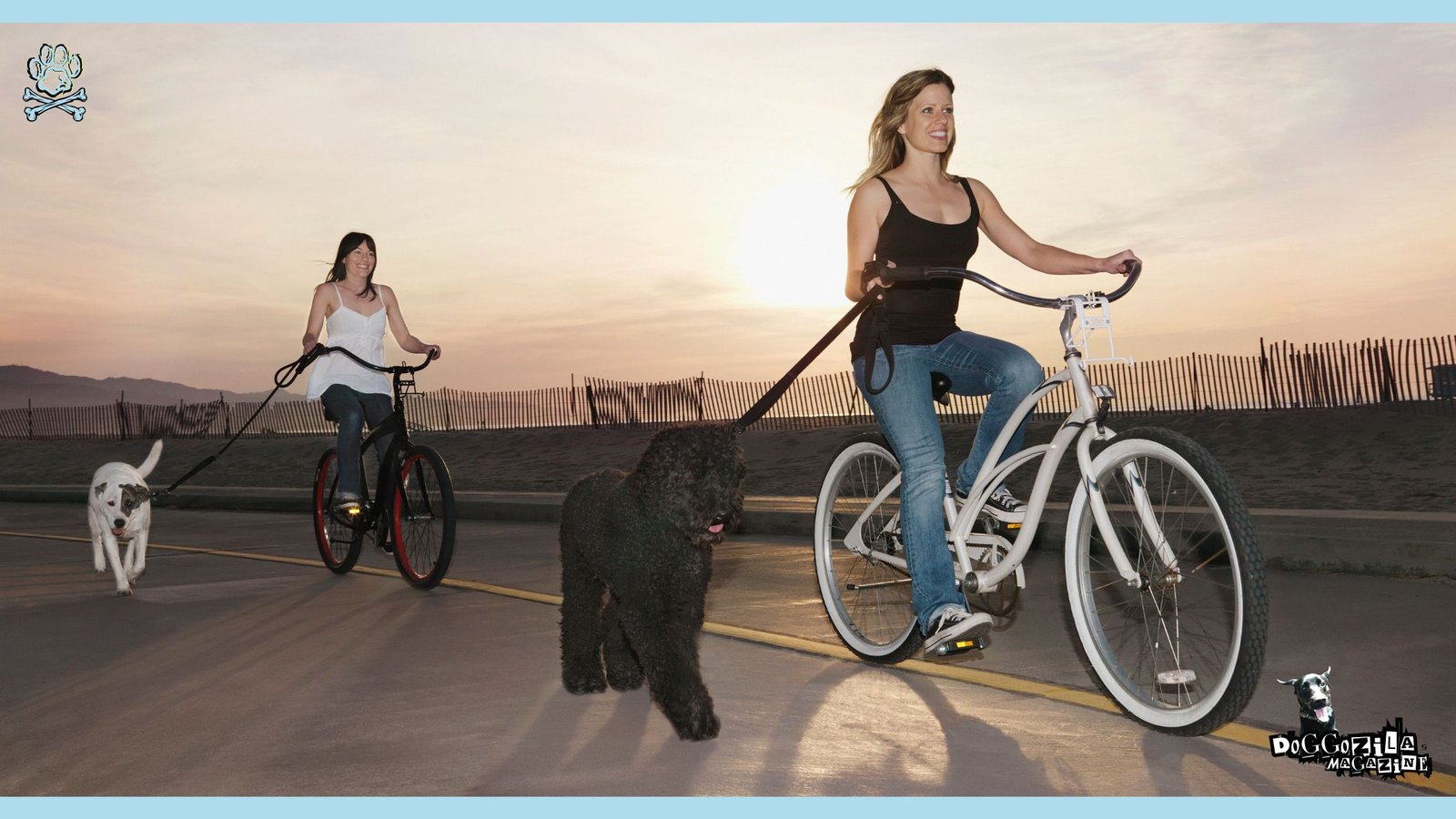
ESSENTIAL BIKING GEAR FOR YOUR DOG
Investing in the right gear is crucial. It ensures a safe and enjoyable biking experience with your dog. From harnesses to leash attachments, there are several essential items.
Harnesses for Optimal Comfort and Control
A well-fitted harness is a must-have for biking with your dog. Look for harnesses designed for active dogs, like those made for special bike attachments. A good harness should distribute weight evenly and prevent choking. It should also provide a secure attachment point for the leash.
Leash Attachments for Safety
When biking with your dog, it’s important to keep them close and under control. Leash attachments designed for biking can help. A runner’s leash or a leash that attaches to your bike’s frame can prevent tangles. It also ensures your dog stays safely by your side.
Reflective and Visibility Gear
If you plan to bike with your furry friend during low-light conditions like early mornings or evenings, reflective gear is a must-have. Look for harnesses, leashes, and collars that have reflective elements. These reflective items will increase your dog’s visibility to other bikers and motorists, keeping them safe. With reflective gear, your pup will be easily spotted, even in dim lighting conditions.
Protective Gear for Paws and Eyes
Depending on the terrain and weather, your dog may need protective gear. Dog booties can shield their paws from hot pavement or rough trails, preventing injuries. Goggles can also protect their eyes from wind, dust, and debris while biking. These protective items ensure your pup’s comfort and safety during outdoor adventures.
🔑 Key Points: Investing in essential biking gear like well-fitted harnesses, leash attachments, reflective elements, and protective gear is crucial. This ensures your dog’s safety and comfort during exciting biking adventures. With the right gear, you can confidently explore trails together.
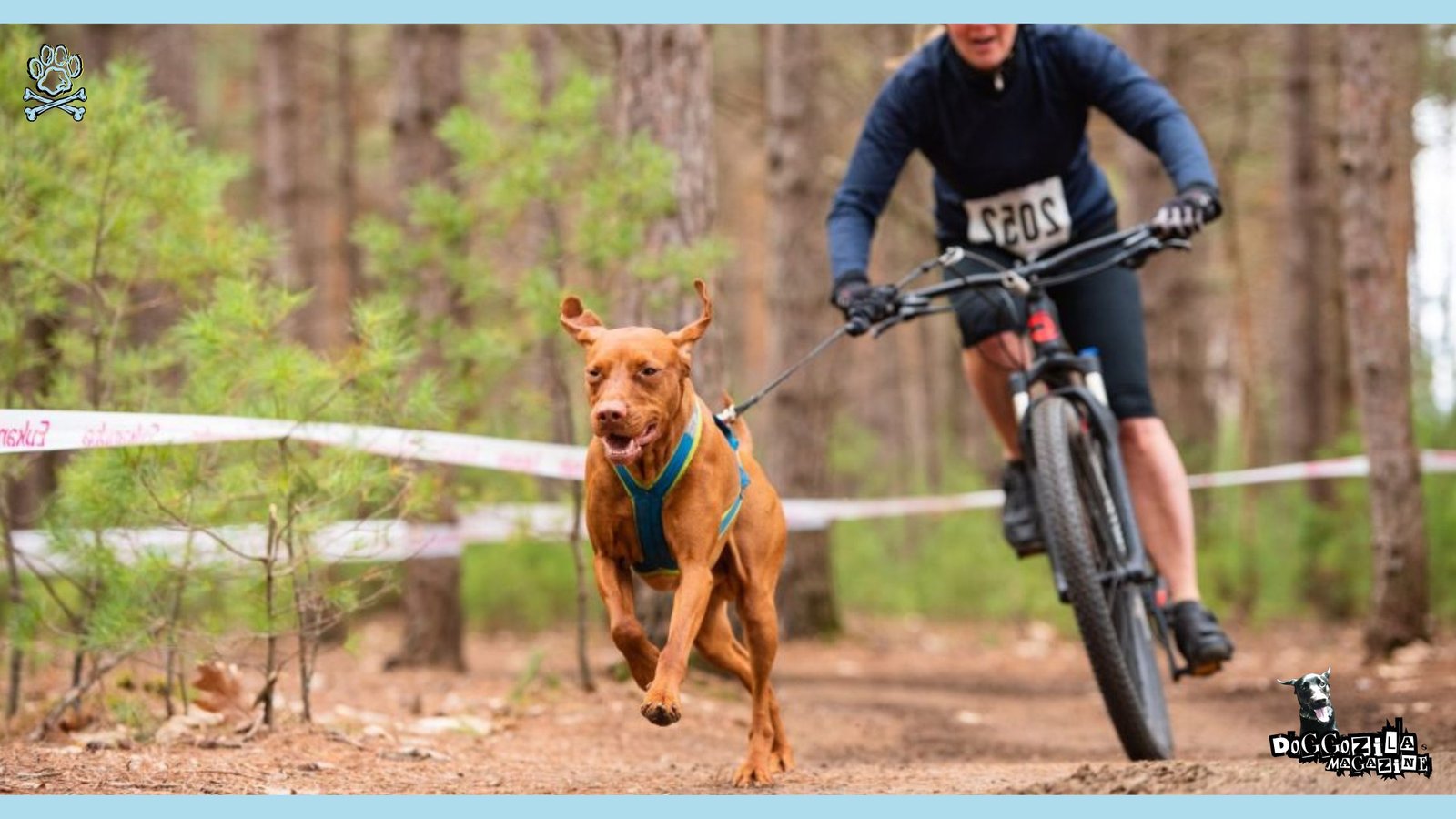
INTRODUCTION TO TRAINING FOR BIKING WITH YOUR DOG
Before hitting the trails with your furry companion, it’s important to train them for biking. Even active dogs need training to ensure a safe and enjoyable experience. With some preparation, you and your pup can embark on thrilling biking adventures together.
Basic Obedience Training
Start with basic obedience commands like “sit,” “stay,” “come,” and “heel.” These commands help you maintain control over your dog while biking. They also keep your pup focused on you. Consistent training strengthens your bond and establishes clear communication.
Introducing the Biking Gear
Familiarize your dog with biking gear like harnesses and leash attachments. Let them sniff and investigate the equipment. Reward them with treats for positive interactions. Gradually introduce the gear during short walks or training sessions. This helps your dog associate the gear with positive experiences.
Practice Sessions in Controlled Environments
Start by training your dog to bike with you in safe areas like a fenced yard or calm park. Take short rides first, and slowly make them longer and harder. Reward good behavior and keep a steady pace. This helps your dog get used to biking.
If you have a new dog or aren’t sure how to train a young pup for biking, ask a pro dog trainer for help. Many places that train dogs offer classes for active dogs. They can give tips to match your dog’s needs.
🔑 Key Points:Training your dog for biking is key. You’ll need obedience training, gear practice, controlled sessions, and pro guidance if needed. This ensures safe, fun trail rides.
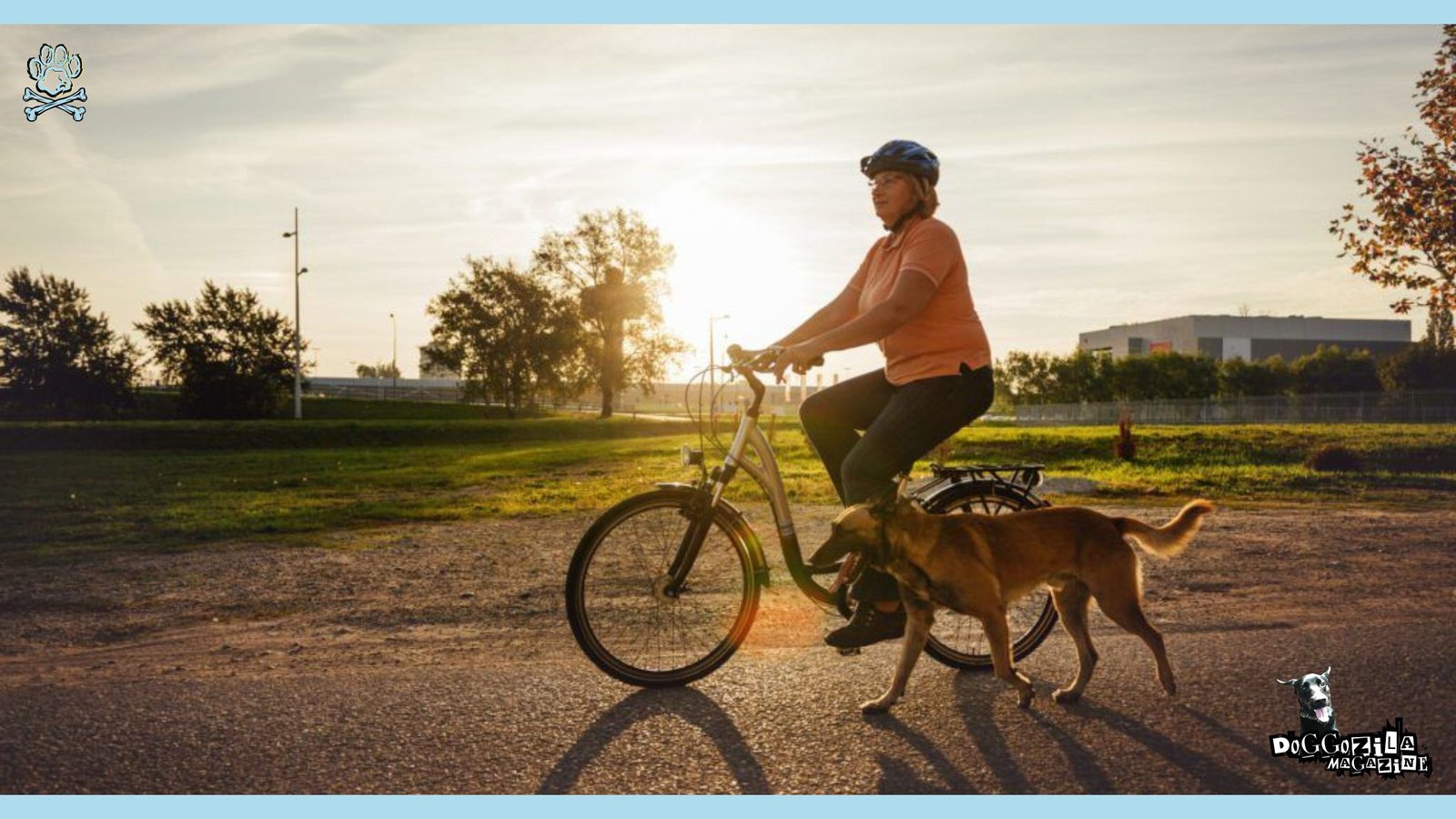
BUILDING UP TO LONGER BIKING RIDES WITH YOUR DOG
Once your dog masters biking basics, you can work up to longer rides. Increasing distance and time slowly builds stamina and prevents overdoing it.
Starting with Short Rides with Gradual Increases in Distance
Begin with short 1-3 mile rides to test your dog’s energy and comfort. These first rides should be like an exercise walk, not too intense. Watch your dog’s body language and energy. Take breaks when needed.
As your dog gets more at ease with biking, slowly raise the ride distance. Try for a 10% growth each week. This lets your dog adjust to the extra workout. But keep an eye out. If your dog struggles, slow the distance rise.
Incorporating Rest Days and Monitoring Your Dog’s Energy Levels
Like humans, dogs require rest between tough workouts. Plan rest days after long rides. Do low-intensity fun like short walks or playtime. This aids muscle recovery. It helps keep your dog healthy too.
Watch your dog’s energy during and post-ride. If they seem very tired, pant heavily, or won’t go on, stop. Your dog’s well-being matters most. Don’t push for distance over safety.
🔑 Key Points: Slowly raise ride lengths with your pup. Increase 10% weekly. Schedule rest days too. Always check your dog’s energy. Stop if they seem tired or stressed.
Hydration And Nutrition On The Go
When biking with your dog, keep them hydrated and fed. Proper water and nutrients fuel their energy. It prevents overheating too.
Providing Fresh Water, Offering Nutritious Snacks and Monitoring Food Intake
Bring a portable water bowl and extra water. Let your dog drink often, especially on hot days. Signs of thirst include panting, lethargy, and dry gums. Pack energy-dense treats like jerky or dog bars. Small, frequent snacks fuel your dog during long rides.
Avoid human snacks with excess salt or sugar. While snacks help, don’t overfeed. Too much can cause digestive upset. Watch your dog’s food signals. Stop if they seem full or uninterested.
🔑 Key Points: Stay hydrated on the trail. Bring water bowls and snacks. Offer small, nutritious treats. But don’t overfeed. Let your pup guide food amounts.
Providing Fresh Water and Identifying Water Sources on the Trail
Always bring a portable dog bowl and bottle filled with clean water. Give your pup water every 15-20 minutes. Offer more water breaks in hot weather. Make water easily accessible and reward your dog with praise for drinking.
Research your biking route beforehand. Look for potential water sources like streams or dog-friendly water fountains. But don’t rely solely on these. Prioritize bringing your own water to ensure your dog has access to fresh, clean water.
Packing Nutritious Snacks and Adjusting Food and Water Intake
Pack your dog’s favorite healthy snacks for the ride. Small, easy-to-digest treats can give a quick energy boost. They also serve as rewards for good behavior. Consider high-protein snacks like cooked chicken pieces or energy bars made for active dogs.
Consider how much food and water your dog usually eats and drinks. Adjust their intake based on the ride’s intensity and duration. For longer rides, offer more frequent water breaks and snacks. This will help keep your dog fueled and hydrated.
🔑 Key Points: Proper hydration and nutrition are essential for your dog’s well-being on biking adventures. Provide fresh water, identify water sources, pack healthy snacks, and adjust food and water intake based on the ride’s intensity. This will ensure your furry friend stays happy and energized.
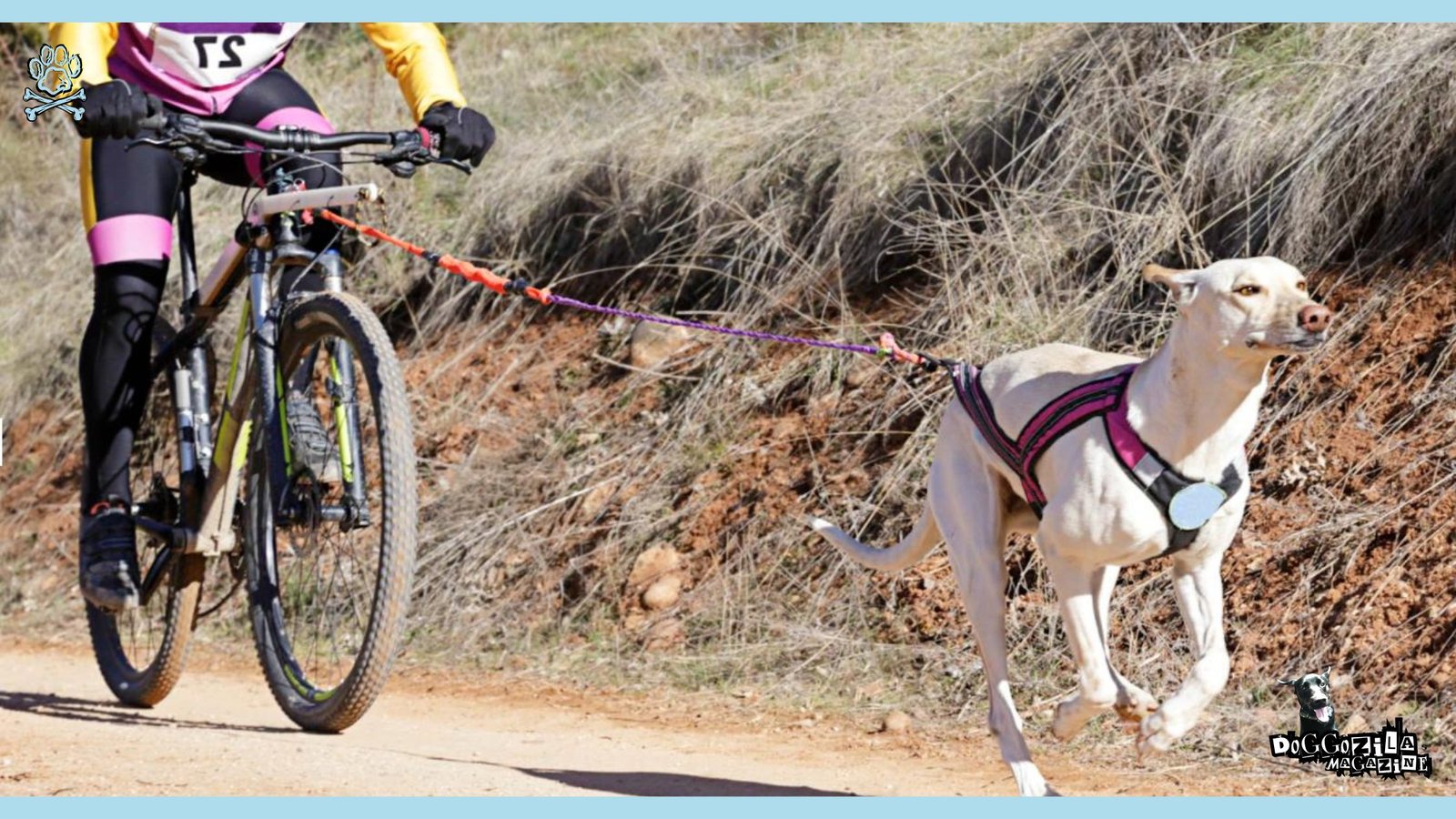
FINDING AND NAVIGATING SAFE PATHS FOR BIKING WITH YOUR DOG
Choosing dog-friendly routes is key for a safe biking trip with your furry friend. When planning, think about the ground, traffic, and possible dangers.
Steps To Take For Planning Biking Adventure With Your Dog
- Researching Dog-Friendly Trails: Look for trails that allow dogs and are safe for biking. Many parks and rec areas have special dog-friendly trails with signs and rules. You can also ask local biking groups or online for good routes near you.
- Considering Ground and Difficulty: Pick routes that match your dog’s fitness level. If new to biking, start on easy trails with smooth ground and gentle slopes. As your dog gets stronger, try harder trails like hiking or mountain biking paths.
- Avoiding Busy Areas: When possible, avoid routes with lots of cars or people. Stick to biking trails or quiet roads to prevent accidents and stress. If biking in a busy area, be very careful and keep your dog close.
🔑 Key Points: For an enjoyable biking trip, prioritize your dog’s safety by using dog-friendly routes, matching the difficulty to their ability, and steering clear of heavy traffic.
Mastering Control And Safety Practices with Appropriate Leash Attachments
Ensuring your dog’s safety and maintaining control while biking is crucial. By following proper safety practices, you can prevent accidents and enjoy a smooth ride. Invest in a sturdy, well-designed leash attachment.
This will keep your dog securely connected to your bike. Don’t use regular leashes, as they can tangle or cause imbalance. Instead, opt for specialized bike leashes or harnesses. These allow controlled movement and quick release in emergencies.
Maintaining a Steady Pace with Usage of Voice Commands and Signals
Keep a steady and predictable pace. Sudden speed changes or erratic movements can startle your dog. This may cause them to pull or veer off course. Maintain a consistent speed that allows your dog to comfortably trot alongside you.
Reinforce your dog’s obedience training by using clear voice commands and signals. Commands like “stop,” “slow,” or “leave it” can help navigate hazards. They also keep your dog focused on the ride. Consistent communication strengthens your bond and improves your dog’s responsiveness.
🔑 Key Points: Mastering control and safety practices is vital for a secure biking experience with your active dog. Use appropriate leash attachments, maintain a steady pace, and employ clear voice commands.
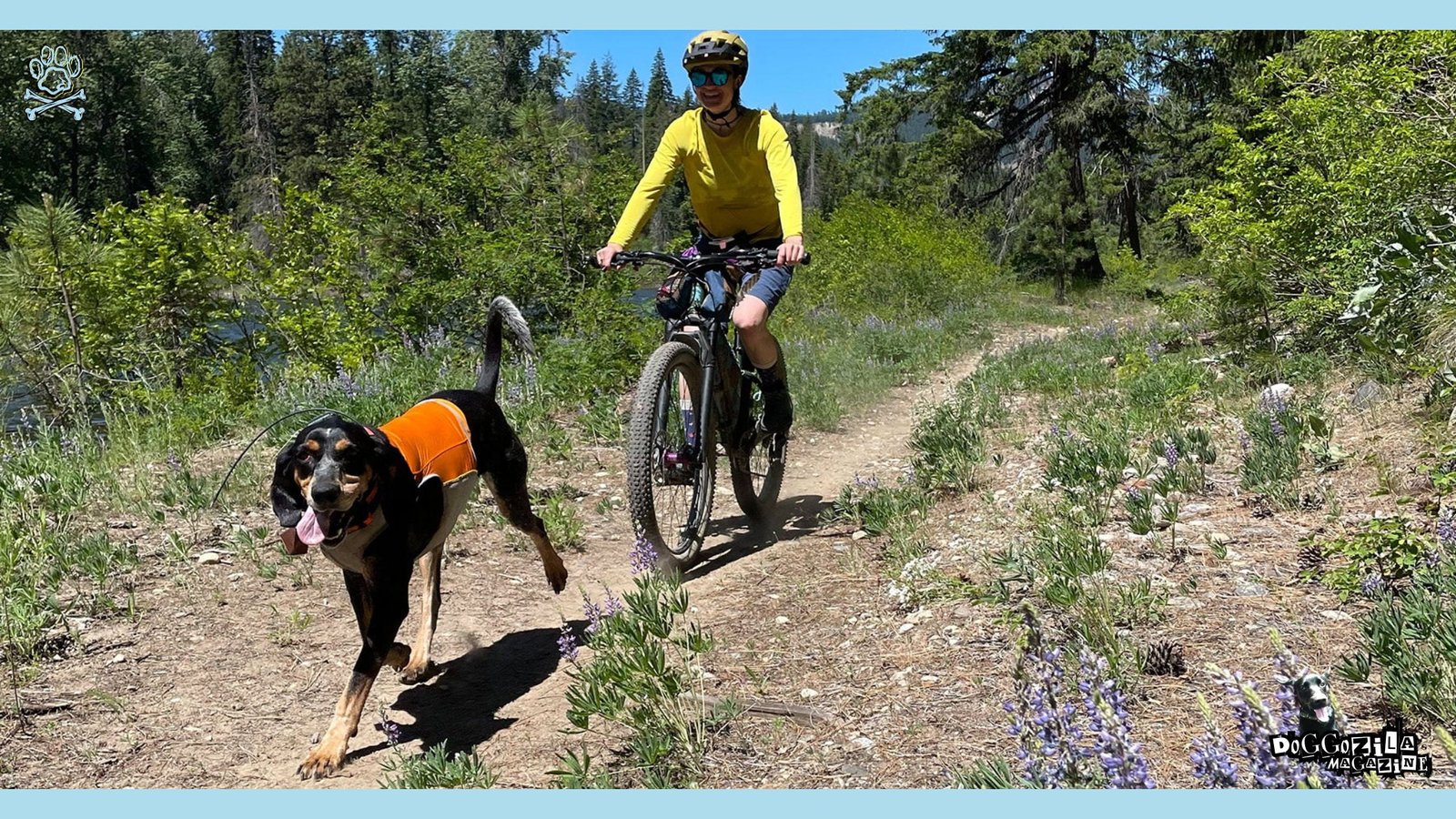
MONITORING YOUR DOG’S WELL-BEING DURING RIDES
Ensuring your dog’s well-being should be a top priority during biking adventures. By monitoring your dog’s physical and emotional state, you can prevent overexertion, dehydration, or distress.
Observing Body Language and Checking for Injuries or Irritations
Pay close attention to your dog’s body language throughout the ride. Signs of fatigue or discomfort may include excessive panting, lagging behind, or a reluctance to continue. If you notice any of these signs, take a break or end the ride if necessary.
Regularly check your dog’s paws, legs, and body for any signs of injury or irritation. Look for cuts, scrapes, or foreign objects that may have become lodged in their paws. If you notice any discomfort or limping, stop the ride and assess the situation.
Providing Rest and Adjusting to Weather Conditions
During your biking adventure, make sure to provide your dog with plenty of opportunities to rest and cool down. Choose shaded areas for breaks, especially during hot weather, and allow your dog to relax and catch their breath.
Be mindful of the weather conditions and how they may affect your dog. On hot days, avoid biking during the hottest hours and stick to cooler, shaded routes. In colder weather, consider using a dog coat or booties to protect your furry friend from the elements.
🔑 Key Points: Monitoring your dog’s well-being during rides, by observing body language, checking for injuries, providing rest and shade, and adjusting to weather conditions, is crucial for ensuring a safe and enjoyable biking experience for your active dog.
Responsible Dog Ownership On Trails with Proper Waste Disposal
As a dog owner, it’s important to be responsible when biking on trails. By following proper etiquette and being considerate, you can help make the experience enjoyable for everyone.
Always carry waste bags. Dispose of your dog’s waste properly. Most trails have designated waste bins. If none are available, pack the waste out. Never leave waste on the trail or in the surrounding area.
Respecting Trail Rules and Yielding to Other Trail Users
Familiarize yourself with the rules and regulations of the trails you plan to use. Some trails may require leashes, have breed restrictions, or seasonal closures. Always follow these guidelines to avoid conflicts and ensure safety.
When encountering other bikers, hikers, or horseback riders, yield the right of way and keep your dog close. If your dog is still learning or gets excited, step off the trail and let others pass safely.
🔑 Key Points: Responsible dog ownership on trails involves proper waste disposal, respecting trail rules, and yielding to others. This helps maintain a positive and safe experience for everyone, including your furry friend.
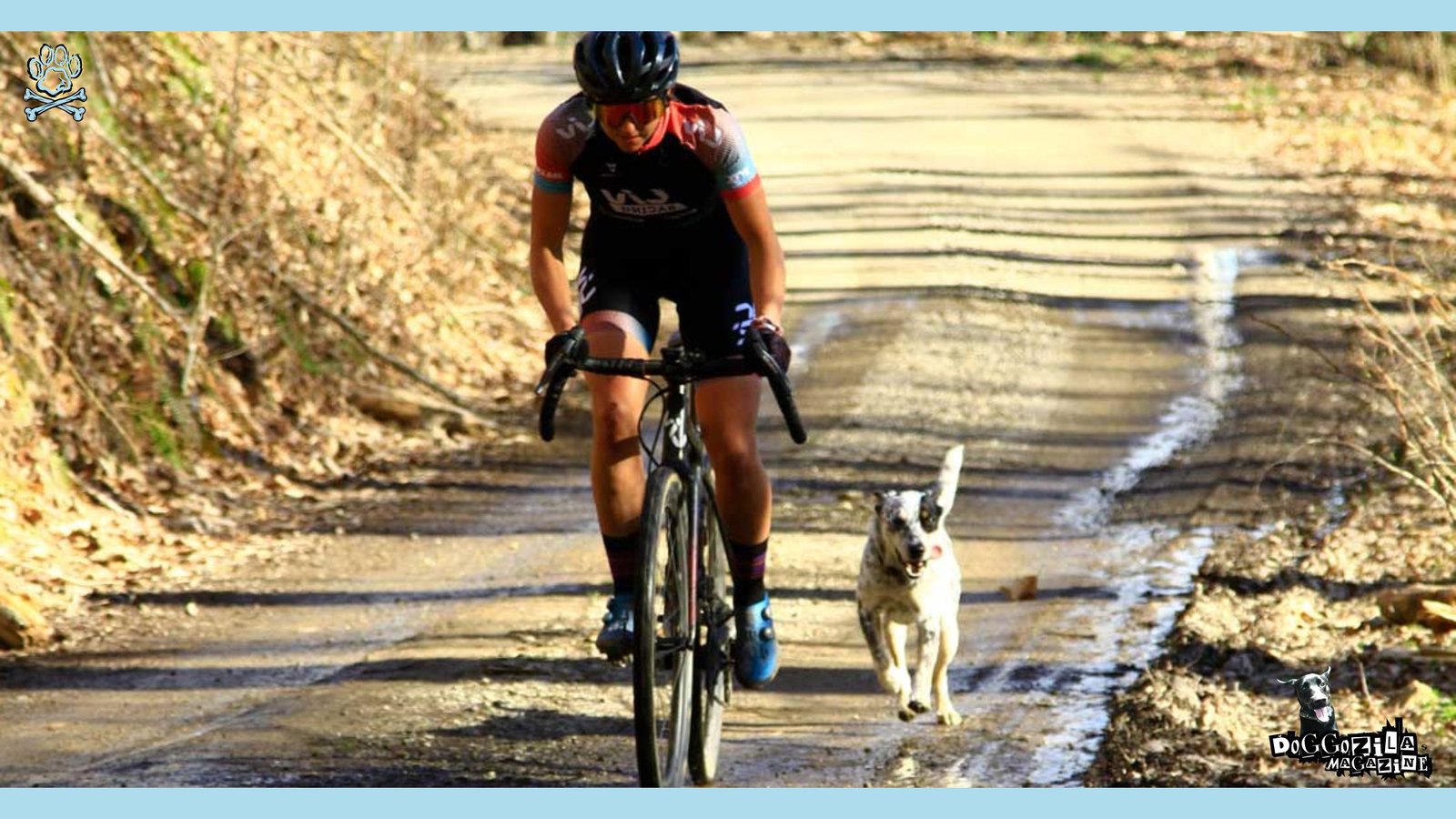
AVOIDING POTENTIAL HAZARDS ON THE TRAIL
When biking with your dog, it’s crucial to be aware of potential hazards. By staying vigilant and prepared, you can minimize risks and ensure a safe ride for both you and your furry companion.
Weather-Related Hazards when Biking with your dog
When biking with your furry companion, you must be mindful of harsh weather conditions. During hot summer days, avoid biking when temperatures peak. Your dog could suffer heat exhaustion or burn their paw pads. In chilly weather, watch for hypothermia symptoms. Consider using protective dog booties to keep their paws warm.
Wildlife Encounters while Biking with your dog
Depending on your biking location, you may encounter wild animals on the trail. Keep your dog close and be ready to distract them if needed. Never allow your dog to chase or interact with wildlife. It could lead to dangerous situations, harming both your pet and the wild creatures.
Terrain-Specific Risks when Biking with your dog
Different terrains present unique challenges for dogs. Rocky or uneven surfaces can injure their paws. Steep inclines or declines may be difficult for some dogs to navigate. Be aware of your dog’s limitations. Choose trails suited for their abilities.
🔑 Key Points: For a safe, enjoyable biking adventure with your trail dog, stay aware of potential hazards. These include extreme weather, wildlife encounters, and terrain-specific risks. Preparation and caution ensure a fun experience for both you and your capable canine companion.
Special Considerations for Different Dog Breeds
When planning a biking trip with your dog, consider their breed’s unique traits and needs. Different breeds have varying physical characteristics, temperaments, and exercise requirements. These factors impact their suitability for biking adventures.
- High-Energy Breeds: Dogs like cattle dogs, hounds, and herding dogs often have high energy and can go for long distances. This makes them good for biking. But you still need to let them rest and drink water. Slowly get them used to biking over time.
- Short-Nosed Breeds: Dogs like pugs, bulldogs, and Boston terriers have a hard time breathing. They may get too hot and tired when biking. Talk to your vet before biking with these breeds. Keep them cool and take breaks.
- Size and Age Considerations: Small dogs may not be able to keep up when biking. Big dogs need more space to move around. Older dogs or those with joint problems need shorter rides and more breaks. Think about your dog’s needs when planning to bike.
Final Thoughts About Why You Should Go Biking With Your Dog
To have fun biking with your dog, you need to know some things. First, make sure your dog is fit and healthy for biking. Ask your vet and get the right gear like a leash attachment. Train your dog for biking slowly. Start with short rides and work up to longer ones.
This way, you and your dog can safely enjoy biking together. Staying hydrated and eating well are key for your dog’s health during rides. Also, find safe routes. Control your dog safely. Check that your dog is doing okay.
Be a good owner on trails. This helps build a strong bond with your furry friend. Avoid dangers. Know any risks for your dog’s breed. Get the right gear for safe rides. Then, every bike trip can bond you two. Enjoy happy times together.
Make great memories on each ride.
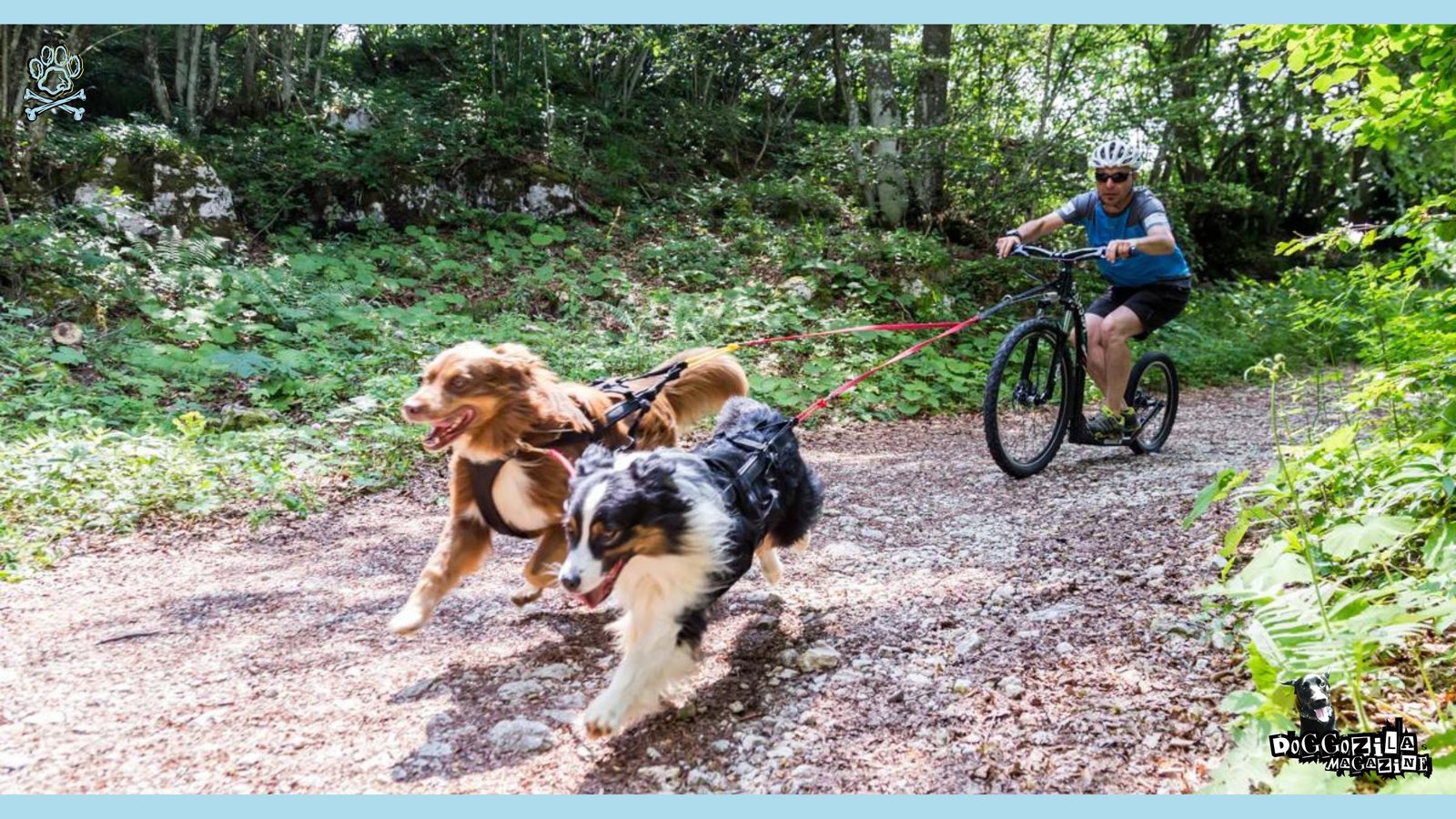
Thanks for joining us on making biking fun with your dog.









